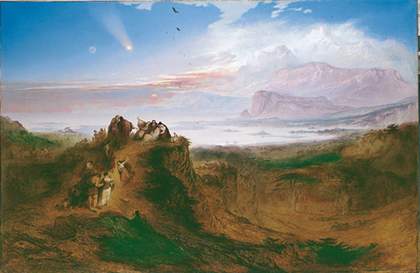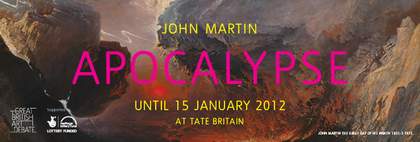
John MartinThe Eve of the Deluge 1840The Royal Collection
Here, the ancient Methuselah (969 years old, we’re told) and his family are clustered on a high rock overlooking an ominous twilight landscape on the night before the Flood. Noah’s Ark can be seen, evoked by a tiny rectangle of paint, sitting on top of a huge cliff in the far, far distance. (There’s little chance you’ll spot this in the image provided here –you need to see it in the flesh really, and then it’s still hard to spot. But it is there, I promise).
The Eve of the Deluge was first exhibited with its companion The Assuaging of the Waters at the Royal Academy in 1840 and again the British Institution in 1841, with the catalogue references to the Bible, ‘And God saw that the wickedness of man, etc.’ (referring to Genesis 6:5-8) and an explanatory note, incorporating lines from Byron’s poem ‘Heaven and Earth’ (1821):
I’ve still not quite worked out which of the figures is meant to be ‘one of the giants’. Martin had giants in an earlier mezzotint of the Deluge itself, although the existence of such oversized humanoids was dismissed as myth by nineteenth-century science.
John Martin’s painting is one of his most strongly coloured and atmospheric … actually, that’s being overly polite. It is really quite gaudy and shocking in the flesh - all confectioner’s pink and blue and caramel brown, and too luminous and slickly painted, lacking in the textural ‘sophistication’ which gains Turner and Constable such plaudits. So we have to remind ourselves that the painting was bought - and presumably greatly appreciated by – none other than Prince Albert (i.e. Mr Queen Victoria).
In a passing remark in his 1956 study of Henry Fuseli, Frederick Antal offers a suggestive thought about Martin: ‘Generally speaking he was a favourite painter with princes, with writers of novels of terror like Bulwer-Lytton, with the large numbers of upper middle-class people who had lower middle-class taste and presumably with the lower middle-class itself’. So, says Antal, the worthy, comfortable, educated middle rank of society (you know the type) just maybe didn’t ‘get’ John Martin. But for the ‘princes’ who didn’t need to bother with rules of conventional taste, for the ‘lower middle-class’ who don’t realise that they’re not getting the rules, he was just the thing.
This brings us round (in a roundabout way) to the question of what we might make of such a picture now, when we stand in front of it in a gallery. In my last blog (‘The Trend is Nigh’) I ventured some comments asking whether our understanding of such pictures matches up at all with that of nineteenth-century viewers, people who knew the bible much better than most of us, went to church more regularly than most of us. Adding in Antal’s comments might lead us to think also about the class basis of different responses to Martin’s art back in the nineteenth century. I’m not sure anyone has really got to the bottom of this yet. But I also suggested that there may be scope for a more ‘spiritual’ or ‘personal’ response. I hope that anyone who reads the exhibition’s interpretation and catalogue will appreciate that we are offering a primarily historical reading of John Martin’s art, in which questions of the ‘spiritual’ and ‘personal’ are not given much space (other than between the lines).
I wonder, still, what we can make of Martin’s paintings now. Are they simply emptied of meaning, ‘spectacle’ in the over-familiar sense of an experience devoid of complexity and value? I have wondered, in looking at the watercolour of the ‘Last Man’ which we have in the show, whether the reason that an image like this resonates now is not because of the way it may offer a ‘profound’ analysis of a ‘profound’ theme in Romantic literature (the final witness to the end of the world), a theme resonant with age-old apocalyptic fears, biblical prophecy, and contemporary anxieties about ecological change and global empire, but because, instead, Martin offers what can appear to us now to be a very effective image of what it feels like to be a 15-year-old feeling terribly isolated in a provincial town, playing computer games and reading comics. Or anyone facing emotional or moral dilemmas/catastrophes (‘It’s not the end of the world, you know’). On a different note, in the interview in the Observer that I cited last time, Ewan McGregor refers to the current apocalyptic film Perfect Sense as ‘a metaphor for falling in love. You know when we say that you lose your senses when you fall in love?’. So what does it mean to be moved, emotionally or even physically, by John Martin’s apocalyptic works now? Martin seems to me to offer an artistic vision of the end of the world which is so superficial that there is little ‘art’ to fall back on, little philosophical ‘depth’ to cushion our thoughts with, thrilling and empty at the same time. But does that matter? Here, indeed, comes the flood.

